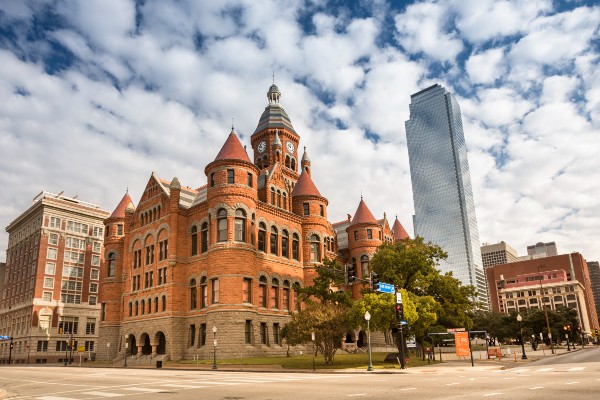As the ninth most populous city in the U.S. and the third largest in Texas, Dallas history is rich with interesting developments.
Texas became a state in 1845, but European settlers started taking over the region much earlier. In 1718, Spanish missionaries founded San Antonio. The state became an independent nation in 1836 before joining the union.
The Texas State Historical Association (TSHA) reports the city of Dallas was founded in November 1841. Today, Dallas is home to some of the country’s most vibrant destinations, as well as beautiful residences, like The Reserve at North Dallas.
>> Read “30 Fun Facts about Dallas and North Dallas”
Here’s a look at Dallas Texas history and how this national destination has grown over the years.
Explore Acclaim at East Beach
The History of Dallas Texas and North Dallas
Dallas history begins with John Neely Bryan, a settler from Tennessee who planted roots along the east bank of the Trinity River in November 1841. Bryan built a cabin on the land, in a spot near a natural ford that was at the intersection of two major Native American traces. As the best crossing point for miles in the region, Bryan’s land became a trading post as other settlers migrated into the region.
Bryan’s settlement was on land that was granted by the republic to the Texan Land and Emigration Company of St. Louis. After Bryan legalized his claim to the land and more settlers followed, in 1844, J.P. Dumas surveyed the land and laid out a town site. The site consisted of a half-mile square of blocks and streets.
The TSHA reports the origin of the name of Dallas isn’t known. Some possibilities include:
- George Mifflin Dallas, who was vice president of the U.S. from 1845 to 1849
- Dallas’ brother Commodore Alexander J. Dallas, of the U.S. Navy
- Joseph Dallas, an early settler who came to the town in 1843
In 1849, the Dallas Herald weekly newspaper was founded. In 1856, the son of one of Dallas’ founding families was shot to death due to a gambling dispute. To enforce law and order, the area’s founders pursued articles of incorporation to become an official town.
Dallas received a town charter from the Texas legislature on Feb. 2, 1856. The first elected mayor was Dr. Samuel Pryor, who led the town government of six aldermen, a constable and a treasurer-recorder.
Economic and Population Growth
Dallas’ prime location led to quick population and economic growth. By the 1850s, the area had grocery stores, a drug store, dry goods stores, brickyards and saddle shops. In the 1850s, substantial numbers of Swiss and German immigrants settled there, as well as French artisans from a nearby colony.
In 1852, the first factory, wagons and manufacturing carriages emerged in Dallas. The same year, a flour mill, a steam sawmill and a three-story brick hotel were created.
By 1860, the town’s population grew to 678 residents, including 97 African-American slaves. After the American Civil War, African-Americans expanded the area further by moving to the area. By 1870, the population reached around 3,000 residents.
In 1872, the Houston and Texas Central railway came to town. In 1873, the Texas and Pacific Railway expanded into the area. Dallas became an exporting hub of goods like leather and buffalo hide and cotton. By 1880, the population reached more than 10,300 residents.
To help get residents from their homes to the railroad interchange, the Dallas City Railroad Company debuted two mule-driven streetcars to transport passengers along Main Street. The streetcar system eventually expanded into a public transit network that covered hundreds of miles of rail throughout Dallas. In 1956, the streetcar system was closed as automobiles and highways took over.
Continued Growth in the 19th and 20th Centuries
Toward the end of the 1800s, banking and insurance became major industries in Dallas and served the growing population. Technology like telephones, which came to the area in 1881, and electricity, which came to Dallas in 1882, helped businesses flourish. Dallas later became the site for a Federal Reserve Bank in 1914.
In 1890, Dallas annexed the neighboring town of East Dallas. At this time, Dallas was the most populous city in Texas, with more than 38,000 residents.
Entering the 1900s, Dallas was the top drug, jewelry, book and wholesale liquor market in the Southwest. Ford opened an auto assembly plant in the city, as well.
By the 1920s, Dallas had become a major center for the textile industry. Female dressmakers joined more than 15,000 women working in 125 professions in Dallas by 1927.
From a population of 42,638 in 1900, the city grew to more than 150,000 by 1920. A wave of thousands of Mexican immigrants fleeing the Mexican Revolution brought them to Dallas in the 1910s.
By 1940, the population had nearly doubled, to reach more than 294,000 people. The city also grew in area, reaching more than 18 square miles in the early 1900s.
In 1931, north Dallas saw the opening of Highland Park Village, one of the country’s first large-scale shopping centers. Dallas business in general continued to boom, as by 1949, five new businesses were opening each day in the area.
Dallas Becomes a Tech Hub
In the 1950s and 1960s, Dallas became the country’s third-largest technology center. In 1958, the integrated circuit computer chip, which became the microchip, was invented in Dallas.
Dallas was home to one of the world’s most shocking events, the assassination of President John F. Kennedy in 1963. Vice President Lyndon Johnson became president while he was in Dallas shortly after.
In 1974, the Dallas-Fort Worth International Airport opened, which helped solidify Dallas as a national hub for business and finance. The population grew to 904,078 in 1980.
Dallas Today
Today, Dallas continues to be one of the country’s leading financial and business centers. Around 6,000 companies are headquartered in Dallas, including hundreds of oil and gas extraction companies and the first convenience store, 7-Eleven.
Dallas is also home to numerous esteemed higher education institutions, theaters and cultural centers, museums and professional sports teams. In July 2021, the U.S. Census Bureau reported more than 1.28 million people live in Dallas, which now spans 343 square miles.
>> Read “13 Things to Do and See In and Around The Reserve’s North Dallas”
Dallas is home to a richly diverse population, with a wide variety of thriving industries. It’s a global destination for its entertainment, business opportunities, natural landscapes and more.
Explore Acclaim at East Beach

Find a New Life for Yourself in Dallas
If you or a loved one is interested in living in a senior care residence in Dallas, The Reserve at North Dallas offers senior Independent Living and Assisted Living options. Find out more about Senior Lifestyle, or schedule a tour today.

